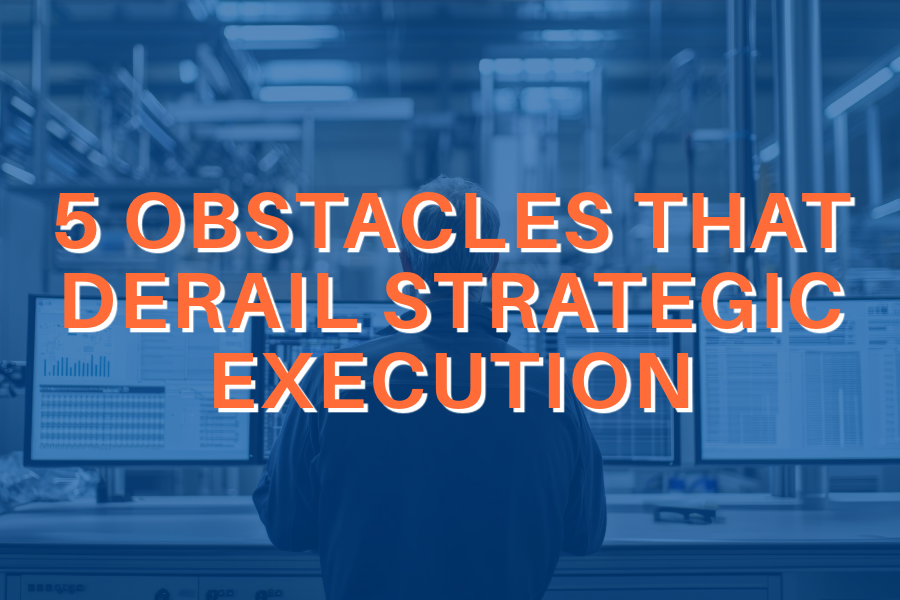In today’s business environment, where competitive advantage can be gained or lost in a single quarter, strategic thinking isn’t just helpful, it’s mission-critical. But thinking big isn’t enough. Without effective execution, even the most insightful strategies struggle to deliver results.
At NEXT LEVEL Partners®, we work closely with leadership teams across industries, and we see a recurring pattern: most organizations don’t fail because of bad ideas. They fail because daily business pressures dilute the discipline required to stay focused, align teams, and move strategy into meaningful action.
As Jim Collins put it, “Greatness is not a function of circumstance. Greatness, it turns out, is largely a matter of conscious choice and discipline.” So we’re laying out five common obstacles that block breakthrough execution so that you can overcome them to move closer to greatness.
1. Too Many Priorities, Not Enough Focus
Organizations are often tempted to do it all. But the truth is, trying to tackle everything at once usually means nothing gets the attention it deserves. When strategic plans balloon into dozens of competing priorities, energy and resources get spread thin, and progress slows.
Gary Keller’s insight in The ONE Thing is particularly relevant here: “Extraordinary results are directly determined by how narrow you can make your focus.”
Strategy becomes powerful when it’s clear and concentrated. Narrowing down to the vital few, those high-impact objectives that truly move the needle and create room for execution and momentum. Without focus, strategy remains a list of wishes.
Countermeasure: Leverage tools like Strategy Deployment (Hoshin Kanri) and the X-matrix to define and communicate the top priorities. These tools don’t just organize ideas, they align the organization around the critical few and create visibility into where effort should be concentrated.
2. Employees Don’t Feel Ownership
Even when leaders believe they’ve communicated the strategy well, employees often perceive it as something handed down from the top, not something they own. And when people don’t feel ownership, they’re far less likely to engage in the work required to make it happen.
We see stronger outcomes when frontline teams help shape how strategy comes to life in their day-to-day work. Within the Hoshin Kanri process, this happens through a mechanism called “catchball”, structured, two-way conversations that give employees a voice and clarify how their work supports bigger objectives.
Countermeasure: Involve employees early and often in the deployment process. Give teams the opportunity to weigh in on how goals are translated into action. This builds alignment, increases buy-in, and turns passive observers into active participants in execution.
3. No Structured Process for Execution
Even the best strategy is just theory until it’s backed by a process that makes it real. Too often, we see plans built with good intentions that sit untouched once the kickoff meeting ends. There’s no cadence, no accountability, and no mechanism for learning or adjusting.
Larry Bossidy said it best in Execution: “Strategies most often fail because they aren’t executed well. Things that are supposed to happen don’t happen.” And as W. Edwards Deming reminds us, “Every system is perfectly designed to get the results it gets.”
To get different results, you need a different system, one that treats execution not as an afterthought, but as a leadership discipline.
Countermeasure: Build a structured rhythm of review and reflection. Monthly strategy reviews, tied to Top-Level Strategic Priorities, help track progress, identify gaps, and ensure that teams stay aligned. When goals aren’t met, leaders should treat that gap as a problem to solve, not a failure to hide.
4. Fear of Failure Blocks Innovation
Many organizations talk about innovation, but their cultures don’t support the risk-taking required to make it happen. When people fear blame, exposure, or criticism, they default to incremental improvements and avoid bold ideas.
Dr. Amy Edmondson, a leading expert on psychological safety, frames it well: “Psychological safety is not about being nice. It’s about giving candid feedback, openly admitting mistakes, and learning from each other.” And Deming’s guidance is just as relevant: “Drive out fear, so that everyone may work effectively for the company.”
The truth is, innovation demands discomfort. Leaders must create space for experimentation, encourage smart risk-taking, and model the vulnerability required to learn in public.
Countermeasure: Normalize feedback, celebrate learning, and frame intelligent failure as part of the path to growth. When people trust that they can speak up and try new things without fear, they bring more creativity and ownership to strategic challenges.
5. Avoiding the Tension That Fuels Growth
Strategy work is inherently uncomfortable. It requires challenging assumptions, confronting gaps, and making hard choices. But too often, leaders interpret discomfort as dysfunction when it’s actually a sign of progress.
In psychology, the concept of eustress refers to positive stress that motivates growth. It’s the tension that sharpens focus, drives learning, and builds resilience. Like a butterfly struggling to emerge from its chrysalis, organizations need that push to develop the muscle for flight.
Countermeasure: Embrace the friction. Help your team understand that strategic discomfort is a natural and necessary part of transformation. Use it to spark better questions, stronger alignment, and bolder thinking.
Breakthrough thinking doesn’t happen in a vacuum. It requires structure, discipline, and the willingness to challenge what’s comfortable. If your team is navigating the complexity of strategy execution, the right tools and mindset can help you move from insight to impact.
At NEXT LEVEL Partners®, we help leadership teams prioritize what matters, create alignment across functions, and build the processes that make strategy stick. Ready to turn your strategic goals into measurable results? Let’s talk.


